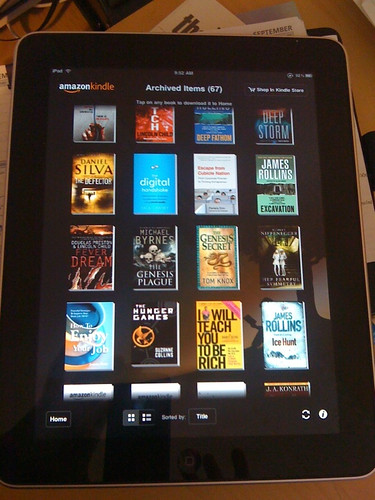This post, by Gary McLaren, originally appeared on his Publish Your Own Ebooks site on 8/11/11.
There are so many different ebook formats in existence that trying to get your ebook into every possible format isn’t practical. However it is a good idea to make your ebook available in the four most popular ebook formats.
But first a little history.
Ebooks have already been around for a while. In the early days of ebooks people tried various ways of packaging ebooks, even including bundling text files into an EXE file. These “ebooks” typically ran on an application that looked like an internet browser and readers could click on buttons to navigate forwards and backwards through the book.
The problem is that downloading EXE files poses a fairly serious security risk to computers and this format quickly lost popularity as people became more aware of the risks of EXE files and computer viruses. It was only a matter of time until better formats were developed.
The four principal formats for ebooks now are:
- Portable Document Format (PDF)
- Kindle Format (AZW)
- Mobipocket Format (MOBI, PRC)
- Epub Format (EPUB)
Now let’s look briefly at each of these formats. Then I’ll give you a table that shows at a glance how these formats correlate to the most popular ebook reading devices.
Portable Document Format (PDF)
In 1993 Adobe Systems created the Portable Document Format (PDF) as a standard format for document exchange. When a document was converted to PDF each page was basically an image of the original document. Since almost all computing devices have the capability to read PDFs, the PDF format has been widely adopted and remains one of the preferred methods of providing documents on the Internet today.
However, a problem arose with PDFs. With improvements in technology we started carrying around smaller and smaller devices. First it was laptops and then even smaller devices including Palm Pilots, Blackberries, and mobile phones.
The early versions of PDF were designed for computer screens and were not very suitable for viewing on smaller screens. Because each page was like an image the text couldn’t be “re-flowed” to fit on tiny screens. Readers became frustrated by the need to scroll horizontally as well as vertically to read a single page in a document.
Several new formats for ebooks have been developed which don’t have this problem. The most popular of these follow here.
Read the rest of the post, which includes a summary table that compares various ereader devices and the ebook formats supported by each, on Gary McLaren‘s Publish Your Own Ebooks site.



















 GRRM is one of the best and most popular fantasy writers, but his A Song Of Ice & Fire series, which started in 1996, has been a long time to completion, and isn’t finished yet. At the end of book 4 it said to expect book 5 in a year. It took six years to see publication. There are still two more books to come, with no release date even hinted at. So people are getting concerned that the whole story may never be told, and the query posted to Neil Gaiman is still valid. As, potentially, is Gaiman’s answer.
GRRM is one of the best and most popular fantasy writers, but his A Song Of Ice & Fire series, which started in 1996, has been a long time to completion, and isn’t finished yet. At the end of book 4 it said to expect book 5 in a year. It took six years to see publication. There are still two more books to come, with no release date even hinted at. So people are getting concerned that the whole story may never be told, and the query posted to Neil Gaiman is still valid. As, potentially, is Gaiman’s answer. Recently, Brent Weeks, author of the Night Angel Trilogy and The Black Prism, posted an
Recently, Brent Weeks, author of the Night Angel Trilogy and The Black Prism, posted an 



